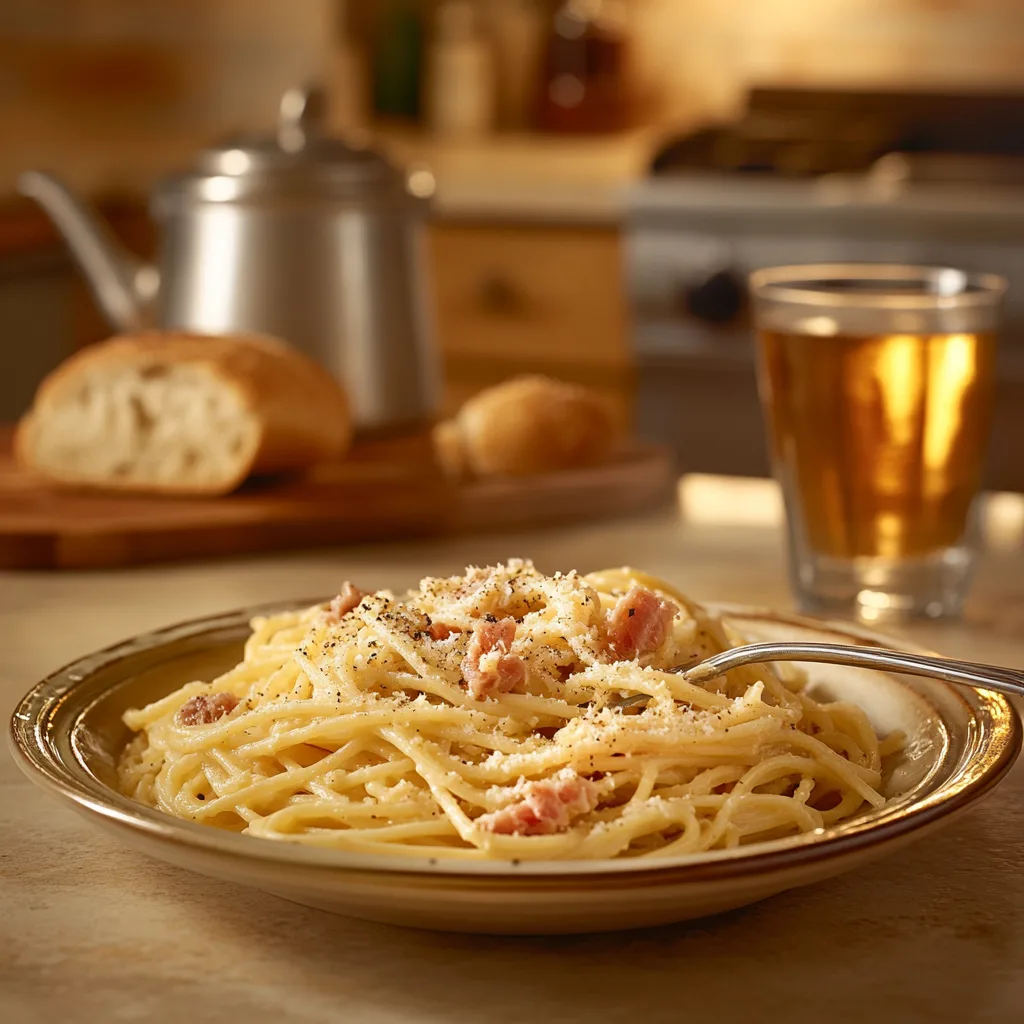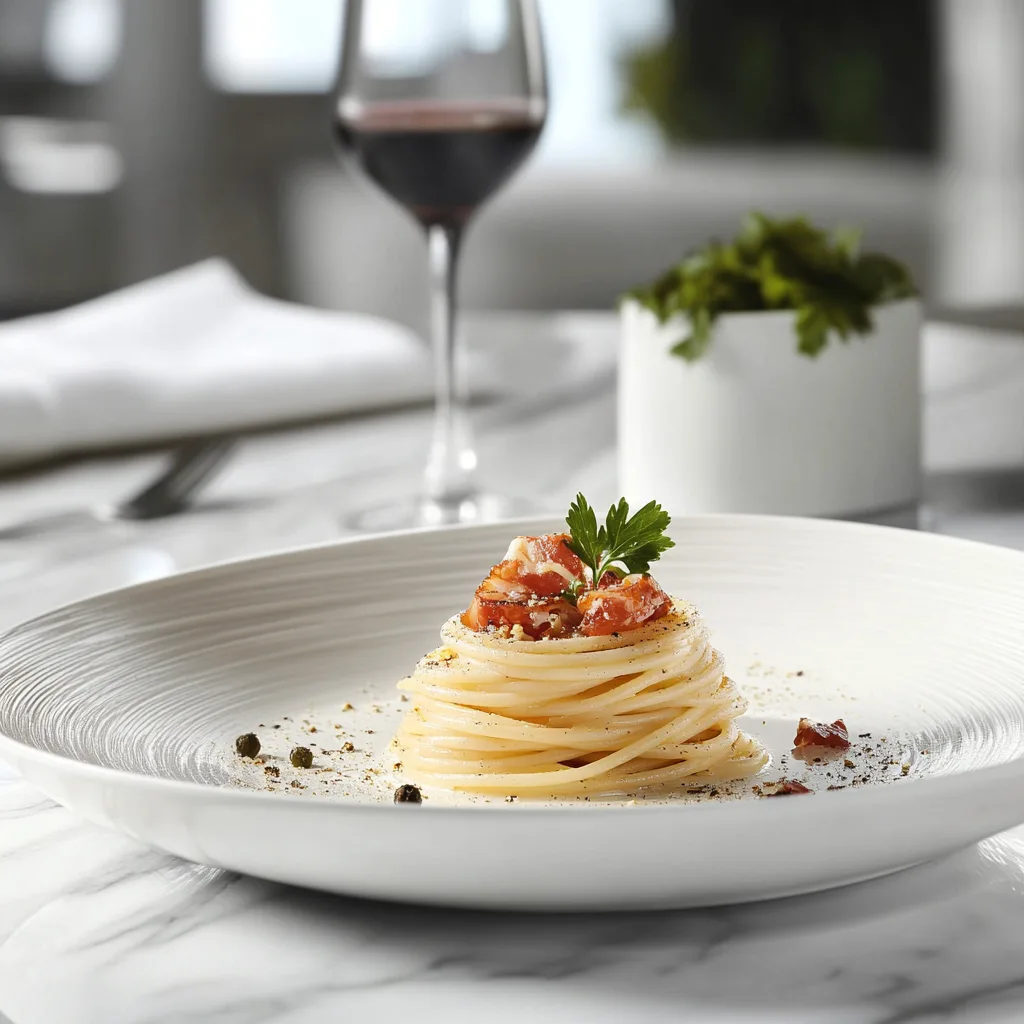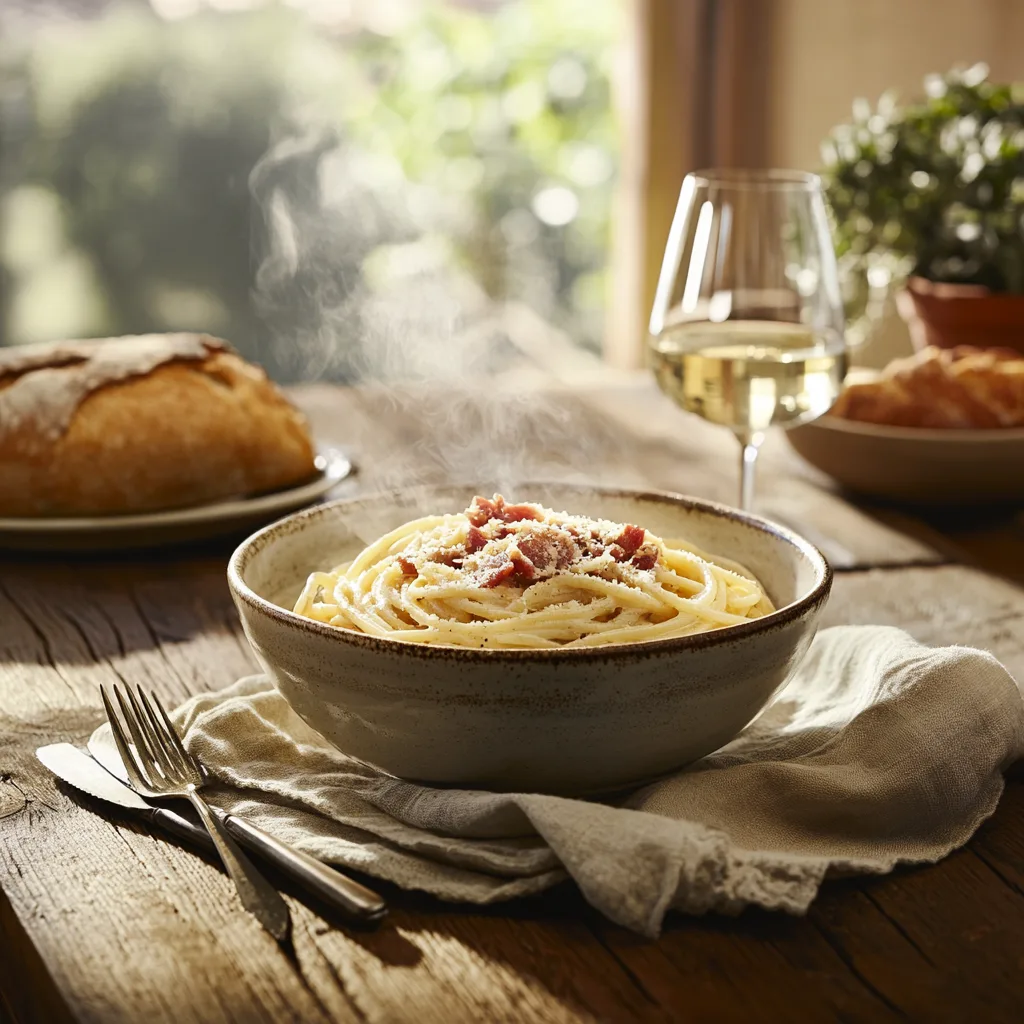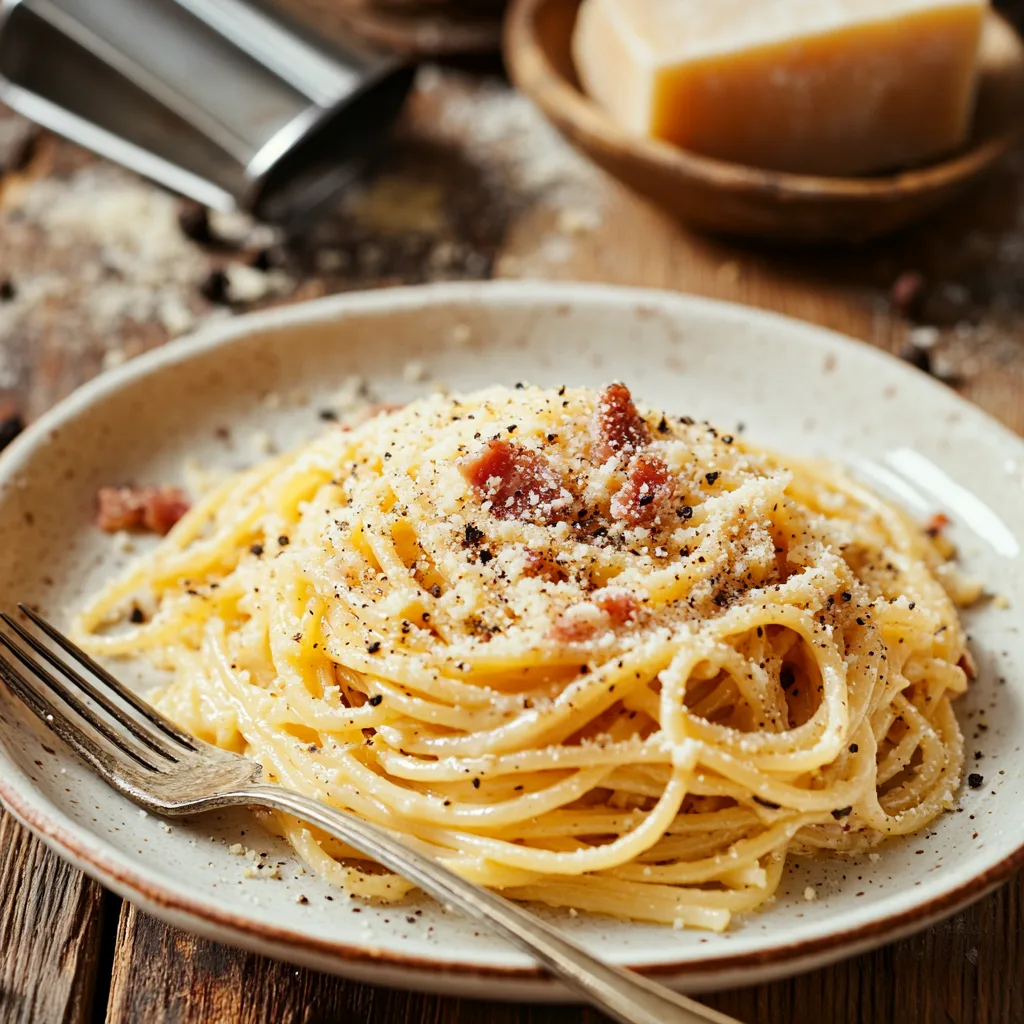Spaghetti Carbonara is the ultimate Italian comfort food, and this guide will show you how to make the perfect Spaghetti Carbonara at home. With its creamy sauce made from Pecorino Romano and egg yolks, crispy guanciale, and freshly cracked black pepper, this classic recipe captures the essence of Roman cuisine.
Spaghetti Carbonara is one of Italy’s most beloved pasta dishes, celebrated for its simplicity, bold flavors, and deep roots in Roman culinary tradition. With just a handful of ingredients—spaghetti, guanciale, Pecorino Romano, egg yolks, and black pepper—this classic dish delivers a rich, creamy sauce without the need for cream, making it a true testament to the elegance of Italian cuisine.
The magic of how to make the perfect Spaghetti Carbonara lies in mastering a few simple techniques: balancing the creamy sauce, cooking the guanciale to perfection, and ensuring the pasta is al dente. Originating in Rome and the Lazio region, Carbonara is a shining example of how high-quality, locally sourced ingredients can create a dish that’s both comforting and sophisticated.
Whether you’re preparing a romantic dinner, hosting friends, or indulging in a comforting meal for yourself, Spaghetti Carbonara is an easy-to-make dish that never fails to impress. In this guide, we’ll walk you through the essential steps, tips, and common mistakes to avoid so you can recreate this iconic Italian recipe in your own kitchen.
Why Spaghetti Carbonara Is a Staple of Italian Cuisine
- A Dish of Simplicity and Elegance:
- Carbonara is the epitome of simplicity, requiring only five main ingredients. Yet, the combination of creamy egg yolks, sharp Pecorino Romano, and crispy guanciale results in a flavor profile that is both bold and luxurious.
- Its straightforward preparation allows home cooks and chefs alike to focus on technique and ingredient quality, hallmarks of Italian cooking.
- Deep Cultural Roots:
- This dish is a cornerstone of Roman cuisine, often enjoyed in trattorias throughout Italy’s capital city. Its origins are deeply tied to the Lazio region, where guanciale (cured pork cheek) and Pecorino Romano are staple ingredients.
- Carbonara represents Italy’s culinary philosophy: creating something extraordinary from humble beginnings.
- Universal Appeal:
- Spaghetti Carbonara transcends borders, loved by food enthusiasts worldwide for its comforting and satisfying taste. Its versatility and quick preparation make it a favorite for weeknight dinners and special occasions alike.
For more on the cultural significance of Carbonara, check out this article on Roman cuisine.
What is Spaghetti Carbonara? A Classic Roman Dish
Spaghetti Carbonara is a quintessential Italian pasta dish with deep roots in Roman cuisine. Known for its creamy texture and rich flavor, this dish exemplifies the beauty of simplicity, relying on a few high-quality ingredients to create a meal that is both comforting and indulgent. Let’s explore the origins, uniqueness, and common misconceptions surrounding this iconic dish.
Origins and History: From Rome to the World
The origins of Spaghetti Carbonara trace back to the Lazio region of Italy, particularly Rome. Though its exact history is debated, Carbonara is believed to have emerged during World War II, when American soldiers in Italy introduced powdered eggs and bacon to the local cuisine. The inventive Romans adapted these ingredients to create a dish using their traditional staples, such as guanciale (cured pork cheek) and Pecorino Romano cheese.
Over time, the recipe evolved into its current form, with its five essential ingredients: spaghetti, guanciale, Pecorino Romano, eggs (mostly yolks), and black pepper. Unlike other Italian pasta dishes, Carbonara does not use heavy sauces or an abundance of spices. Instead, it focuses on the natural flavors of its ingredients, making it a masterpiece of culinary simplicity.
Key Historical Points:
- Its name, “Carbonara,” is thought to derive from carbonaro, meaning “charcoal burner” in Italian, suggesting it was a hearty meal for workers.
- The dish gained widespread popularity during the post-war period as it traveled beyond Rome and became a beloved classic around the globe.
For more on the history of Spaghetti Carbonara, check out this guide to Italian pasta dishes.
Why It’s Special: Simplicity Meets Sophistication
Spaghetti Carbonara stands out for its ability to transform simple ingredients into a dish bursting with flavor. Here’s why it’s so beloved:
- Balance of Simplicity and Rich Flavor:
- Carbonara’s creamy texture is achieved without cream, relying on the emulsification of egg yolks, cheese, and starchy pasta water.
- The guanciale adds a savory, slightly smoky note, perfectly complemented by the sharpness of Pecorino Romano and the heat of freshly cracked black pepper.
- High-Quality Ingredients are Key:
- The dish’s success depends entirely on the quality of its components. Authentic Pecorino Romano cheese, cured guanciale, and fresh eggs make all the difference.
- Even the pasta water, rich in starch, plays a crucial role in creating the luxurious sauce.
- Cultural and Culinary Significance:
- In Rome, Carbonara is more than a meal—it’s a tradition. It is served in almost every trattoria and is a must-try for anyone visiting the Eternal City.
Common Misconceptions: Debunking Carbonara Myths
Despite its global fame, Spaghetti Carbonara is often misunderstood and misinterpreted. Let’s clear up some of the most common misconceptions:
Some recipes add garlic, onions, or herbs, but these are not traditional. The simplicity of the original recipe is what makes it so remarkable.
The Cream Debate:
Traditional Carbonara does not contain cream. The creamy consistency comes from the careful combination of egg yolks, Pecorino Romano, and pasta water. Adding cream is considered an inauthentic shortcut that dilutes the dish’s flavor.
Substituting Guanciale with Bacon:
While bacon is often used outside of Italy, it lacks the depth and richness of guanciale. Pancetta is a closer substitute, but true Carbonara relies on guanciale’s unique texture and flavor.
Essential Ingredients for Authentic Spaghetti Carbonara
Creating authentic Spaghetti Carbonara requires just a handful of carefully chosen ingredients. Each component plays a vital role in achieving the dish’s signature flavor, texture, and simplicity. Let’s explore the essentials and how they contribute to making the perfect Carbonara.
The Pasta: Why Spaghetti is the Star
The name Spaghetti Carbonara suggests the use of spaghetti, and for good reason. Its long, slender strands are perfect for capturing the creamy sauce and bits of guanciale, making each bite a flavorful delight.
- Why Spaghetti is Traditionally Used:
- Spaghetti’s texture allows it to absorb just the right amount of sauce, ensuring a balanced bite.
- Its long shape ensures even coating when tossed with the Carbonara sauce.
- Alternative Pasta Options:
- Bucatini: A thicker, hollow pasta that holds the sauce well while adding a satisfying chew.
- Rigatoni: A tubular pasta that can trap bits of guanciale and sauce inside its ridges.
- Key Tip for Cooking Pasta:
- Always cook the pasta al dente (firm to the bite) and reserve some starchy pasta water to help emulsify the sauce.
Guanciale or Substitutes: The Heart of the Dish
Guanciale, a cured pork cheek, is the traditional choice for Carbonara, providing a rich, savory base that defines the dish.
- What is Guanciale?
- Guanciale is cured pork cheek with a high fat content that melts into the dish, adding a luxurious depth of flavor.
- Its slightly peppery, salty profile pairs perfectly with Pecorino Romano and egg yolks.
- Substitutes for Guanciale:
- Pancetta: Cured pork belly, similar to bacon but without the smoky flavor. It’s a suitable substitute, though less authentic.
- Bacon: Widely available but not ideal due to its smokiness, which can overpower the dish.
- How to Prepare Guanciale:
- Dice it into small cubes or strips and render the fat slowly over medium heat until crispy. The rendered fat becomes the flavorful base for the sauce.
Pecorino Romano vs Parmesan: The Cheese Debate
Cheese plays a critical role in Carbonara, contributing its salty, tangy flavor and creamy texture to the sauce.
- Why Pecorino Romano is Preferred:
- Made from sheep’s milk, Pecorino Romano has a sharp, salty flavor that stands up to the richness of guanciale and egg yolks.
- Its granular texture blends seamlessly into the sauce, creating a smooth consistency.
- Using Parmesan as a Substitute:
- Parmesan (Parmigiano-Reggiano) is milder and less salty than Pecorino Romano. While it can be used, it won’t deliver the same robust flavor.
- For a balanced option, use a mix of Pecorino Romano and Parmesan.
- Key Tip for Grating Cheese:
- Grate the cheese finely to ensure it melts evenly into the sauce, preventing clumps.
Eggs and Black Pepper: The Creamy Core
The creamy sauce of Carbonara comes from egg yolks, combined with grated cheese and pasta water—no cream required.
- Role of Egg Yolks:
- Egg yolks are the backbone of the sauce, providing richness and a velvety texture.
- Using only yolks (rather than whole eggs) ensures a creamy consistency without becoming watery.
- How to Prevent Scrambled Eggs:
- Combine the egg yolks and cheese in a bowl before tossing with the hot pasta.
- Add the mixture off the heat and toss vigorously with reserved pasta water to create an emulsion.
- Freshly Ground Black Pepper:
- Adds a mild heat and aromatic depth to the dish.
- Toast the pepper lightly in the rendered guanciale fat for enhanced flavor.
Pro Tip: Ingredient Quality Matters
The key to authentic Spaghetti Carbonara is using high-quality, fresh ingredients. Opt for artisanal Pecorino Romano, locally sourced guanciale, and farm-fresh eggs whenever possible.
Step-by-Step Guide to Making Perfect Spaghetti Carbonara
Creating the perfect Spaghetti Carbonara requires mastering a few essential techniques. By following these steps carefully, you’ll achieve the creamy texture, rich flavor, and authentic taste that make this dish a standout in Italian cuisine.
Cook the Pasta
The foundation of any pasta dish lies in perfectly cooked pasta, and for Carbonara, spaghetti is the traditional choice. Here’s how to get it just right:
- Boil the Pasta:
- Fill a large pot with water and bring it to a rolling boil.
- Add a generous amount of salt to the water—it should taste like the sea. This is the only chance to season the pasta itself.
- Cook to Al Dente:
- Add the spaghetti to the boiling water and cook until al dente (firm to the bite). This usually takes about 8–10 minutes, but check the package instructions for specific timing.
- Reserve about 1 cup of the starchy pasta water before draining. This liquid will be key to emulsifying the sauce.
- Avoid Rinsing the Pasta:
- Do not rinse the cooked spaghetti, as the starch clinging to it helps bind the sauce.
For more on cooking pasta, see this guide to perfect pasta cooking.
Prepare the Guanciale
Guanciale is the star ingredient that gives Carbonara its savory, slightly smoky flavor. Preparing it correctly is essential for a well-balanced dish.
- Dice the Guanciale:
- Cut guanciale into small cubes or thin strips, depending on your preference.
- Render the Fat:
- Heat a large skillet over medium heat and add the guanciale. Cook slowly to render the fat, allowing the guanciale to crisp up without burning.
- This process takes about 5–7 minutes, and the fat will turn golden and flavorful.
- Save the Rendered Fat:
- Remove the crispy guanciale with a slotted spoon and set aside. Leave the rendered fat in the skillet—it will be used to flavor the pasta and enhance the sauce.
Mix the Sauce
The creamy sauce of Carbonara is created without cream. It’s a delicate emulsion of egg yolks, Pecorino Romano, and black pepper.
- Combine Ingredients:
- In a mixing bowl, whisk together 4–5 egg yolks (depending on serving size), 1 cup of grated Pecorino Romano, and freshly ground black pepper to taste.
- The mixture should be thick and smooth, with no lumps of cheese.
- Season Lightly:
- Avoid adding salt to the sauce at this stage. The Pecorino Romano and guanciale provide enough saltiness.
- Prepare for Emulsification:
- Have the reserved pasta water ready, as it will help create a creamy sauce without scrambling the eggs.
Combine Everything
This step is where the magic happens, transforming simple ingredients into a cohesive, creamy dish.
Taste the pasta and adjust with more black pepper or grated Pecorino Romano as needed.
Toss the Pasta in the Skillet:
Add the drained spaghetti to the skillet with the rendered guanciale fat. Toss to coat the pasta evenly.
Add the Egg Mixture Off the Heat:
Remove the skillet from the heat to prevent the eggs from scrambling. Pour the egg mixture over the pasta, tossing vigorously with tongs or a wooden spoon.
Emulsify the Sauce:
Slowly add the reserved pasta water, a few tablespoons at a time, while tossing. The heat of the pasta and the starchy water will create a silky, creamy sauce that clings to each strand of spaghetti.
Fold in the Guanciale:
Return the crispy guanciale to the skillet and toss gently to distribute evenly.
Adjust Seasoning:
Taste the pasta and adjust with more black pepper or grated Pecorino Romano as needed.



Tips, Variations, and Common Mistakes to Avoid
Mastering Spaghetti Carbonara requires attention to detail and a willingness to experiment with variations while staying true to its traditional roots. Below are essential tips for success, creative adaptations, and pitfalls to avoid to ensure your Carbonara is perfect every time.
Tips for Success: Achieve the Perfect Texture and Flavor
- Use Room-Temperature Eggs:
- Eggs at room temperature blend more easily with cheese and pasta water, creating a smooth and creamy sauce. Cold eggs may not emulsify properly, leading to uneven texture.
- Gradually Add Pasta Water:
- The starchy pasta water is key to creating a luscious sauce. Add it gradually while tossing the pasta and egg mixture off the heat. This prevents curdling and helps bind the ingredients into a silky coating.
- Use High-Quality Ingredients:
- Authentic guanciale, Pecorino Romano, and fresh eggs make a significant difference. High-quality ingredients ensure robust flavors and an authentic Italian experience.
- Serve Immediately:
- Carbonara is best served fresh. Allowing it to sit can cause the sauce to thicken too much or lose its creamy texture.
Popular Variations: Creative Twists on a Classic
While traditional Carbonara is perfect as it is, there’s room for creativity if you want to cater to different dietary preferences or experiment with flavors:
- Vegetarian Carbonara:
- Replace guanciale with sautéed mushrooms, which add a meaty texture and umami flavor. Smoked tofu or eggplant can also mimic the savory notes of guanciale.
- Using Pancetta or Bacon as Substitutes:
- While guanciale is traditional, pancetta (cured pork belly) or bacon can be used in a pinch. Pancetta is closer in flavor, but bacon’s smokiness can alter the dish’s profile.
- Mixed Cheese Options:
- Blend Pecorino Romano with Parmigiano-Reggiano for a milder yet equally delicious result.
- Gluten-Free or Whole-Grain Options:
- Swap regular spaghetti for gluten-free pasta or whole-grain options to accommodate dietary needs.
- Vegan Carbonara:
- Use a blend of silken tofu, nutritional yeast, and black salt to replicate the creamy texture and flavor of the sauce. Add smoked mushrooms or vegan bacon for depth.
Common Mistakes to Avoid: Learn from the Pros
Even seasoned cooks can stumble when making Carbonara. Avoid these common pitfalls to ensure success:
- Overcooking the Egg Mixture (Scrambled Eggs):
- Adding the egg mixture to a hot pan can cause it to scramble. Always remove the skillet from the heat before tossing the pasta with the sauce. Toss vigorously and add pasta water gradually to prevent clumping.
- Using Cream (Which is Not Traditional):
- Traditional Carbonara relies on egg yolks and Pecorino Romano for its creamy texture. Adding cream dilutes the flavor and veers away from authentic Roman tradition.
- Skipping Fresh Black Pepper:
- Freshly cracked black pepper is essential for Carbonara’s signature spice and aroma. Pre-ground pepper lacks the same depth of flavor and can diminish the dish’s overall impact.
- Skipping the Rest Period:
- Allow the dish to rest for 1–2 minutes after tossing to let the sauce thicken slightly. Skipping this step can result in a watery sauce.
- Using the Wrong Cheese or Meat:
- Parmesan and bacon are common substitutes, but they don’t deliver the same authentic flavor as Pecorino Romano and guanciale. Stick to traditional ingredients whenever possible.
Explore common pasta mistakes and how to fix them.
Pro Tip: Balance Creativity with Tradition
While variations are fun to explore, staying true to traditional techniques and high-quality ingredients ensures the best results. Start with the classic recipe, then experiment with flavors to suit your preferences.
Serving Suggestions and Pairings
A perfectly prepared Spaghetti Carbonara deserves an equally thoughtful presentation and accompaniment. From garnishes to side dishes and wine pairings, these suggestions will elevate your dining experience and highlight the rich, creamy flavors of this classic Italian dish.
Garnish: The Finishing Touch
- Extra Pecorino Romano:
- Once plated, sprinkle a generous amount of finely grated Pecorino Romano over the top. This enhances the flavor and adds a touch of visual appeal with its snowy, granular texture.
- Use a microplane for a fine, even garnish.
- Freshly Cracked Black Pepper:
- Finish with a dusting of freshly cracked black pepper to accentuate the spice and aroma of the dish. For maximum flavor, use a coarse grind.
- Optional Garnishes:
- While traditional Carbonara doesn’t include herbs, a small sprig of fresh parsley can add a pop of color for presentation.
- Keywords: Carbonara garnish ideas, Pecorino Romano topping, finishing touches for Italian pasta
- LSI Keywords: black pepper for pasta, fresh cheese garnish, plating pasta dishes
- Entities: Pecorino Romano, black pepper, parsley
Side Dishes: Simple Complements to Balance the Meal
Spaghetti Carbonara is rich and indulgent, so pairing it with lighter sides can create a well-rounded meal.
- Arugula Salad:
- A fresh arugula salad with a simple lemon vinaigrette is the perfect contrast to Carbonara’s creamy texture. Add shaved Parmesan and toasted pine nuts for an elegant touch.
- Garlic Bread:
- Warm, crusty garlic bread adds a satisfying crunch and complements the flavors of the pasta. Use fresh garlic and a good-quality olive oil for authenticity.
- Roasted Vegetables:
- Serve alongside roasted asparagus, zucchini, or cherry tomatoes for a colorful, seasonal accompaniment that balances the richness of the dish.
- Antipasto Platter:
- Start the meal with an antipasto platter featuring cured meats, olives, marinated artichokes, and fresh mozzarella for an authentic Italian experience.
- Keywords: side dishes for Carbonara, arugula salad with pasta, Italian dinner ideas
- LSI Keywords: light sides for creamy pasta, pairing salads with pasta, traditional Italian sides
- Entities: arugula, garlic bread, antipasto platter
Wine Pairings: The Perfect Sip
Pairing the right wine with Spaghetti Carbonara enhances the dish’s flavors and rounds out the dining experience:
- Crisp White Wines:
- A Pinot Grigio or Sauvignon Blanc complements the creamy sauce with its acidity and light body.
- Look for options with citrus notes to contrast the richness of guanciale and Pecorino Romano.
- Light Red Wines:
- A Chianti or Barbera offers a balance of fruity and earthy flavors, making it an excellent choice for those who prefer red wine.
- Sparkling Options:
- A dry Prosecco or sparkling wine provides a refreshing palate cleanser between bites.
- Non-Alcoholic Pairing:
- For non-drinkers, a sparkling water with a slice of lemon or a lightly flavored iced tea pairs well.
- Keywords: wine pairings for Spaghetti Carbonara, best wines for creamy pasta, Italian wine with Carbonara
- LSI Keywords: pairing red wine with pasta, white wine for creamy dishes, Italian wine recommendations
- Entities: Pinot Grigio, Chianti, Prosecco, Sauvignon Blanc
For more wine pairing tips, visit this guide to pairing wine with pasta dishes.
Now that you’ve learned how to make perfect Spaghetti Carbonara, why not try it with your own twist? Whether you opt for a vegetarian variation or stick to the classic recipe, we’d love to hear about your experience!
Tag us in your Spaghetti Carbonara creations on Instagram using #PerfectCarbonara for a chance to be featured!”
Looking for More Recipes?
If you enjoyed this recipe, be sure to check out other comfort food classics on my blog! From hearty casseroles to soul-warming soups, there’s something for everyone. Here are a few suggestions:
- The Best Classic Meatloaf Recipe: A Timeless Comfort Food Favorite
- Authentic Italian Lasagna Recipe: Straight from Nonna’s Kitchen
- How to Make Perfect Paella: Tips and Step-by-Step Recipe


2 thoughts on “How to Make the Perfect Spaghetti Carbonara: Classic Italian Recipe”
Comments are closed.